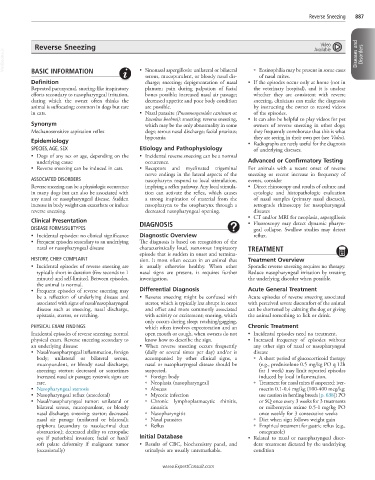Page 1764 - Cote clinical veterinary advisor dogs and cats 4th
P. 1764
Reverse Sneezing 887
Video
Reverse Sneezing Available
VetBooks.ir Diseases and Disorders
• Sinonasal aspergillosis: unilateral or bilateral
BASIC INFORMATION
of nasal mites.
serous, mucopurulent, or bloody nasal dis- ○ Eosinophilia may be present in some cases
Definition charge; sneezing; depigmentation of nasal • If the episodes occur only at home (not in
Repeated paroxysmal, snoring-like inspiratory planum; pain during palpation of facial the veterinary hospital), and it is unclear
efforts secondary to nasopharyngeal irritation, bones possible; increased nasal air passage; whether they are consistent with reverse
during which the owner often thinks the decreased appetite and poor body condition sneezing, clinicians can make the diagnosis
animal is suffocating; common in dogs but rare are possible. by instructing the owner to record videos
in cats. • Nasal parasite (Pneumonyssoides caninum or of the episodes.
Eucoleus boehmi): sneezing; reverse sneezing, • It can also be helpful to play videos for pet
Synonym which may be the only abnormality in some owners of reverse sneezing in other dogs;
Mechanosensitive aspiration reflex dogs; serous nasal discharge; facial pruritus; they frequently corroborate that this is what
hyposmia they are seeing in their own pet (see Video).
Epidemiology • Radiographs are rarely useful for the diagnosis
SPECIES, AGE, SEX Etiology and Pathophysiology of underlying diseases.
• Dogs of any sex or age, depending on the • Incidental reverse sneezing can be a normal
underlying cause occurrence. Advanced or Confirmatory Testing
• Reverse sneezing can be induced in cats. • Receptors and myelinated trigeminal For animals with a recent onset of reverse
nerve endings in the lateral aspects of the sneezing or recent increase in frequency of
ASSOCIATED DISORDERS nasopharynx respond to local stimulation, events, consider
Reverse sneezing can be a physiologic occurrence implying a reflex pathway. Any local stimula- • Direct rhinoscopy and results of culture and
in many dogs but can also be associated with tion can activate the reflex, which causes cytologic and histopathologic evaluation
any nasal or nasopharyngeal disease. Sudden a strong inspiration of material from the of nasal samples (primary nasal diseases),
increase in body weight can exacerbate or induce nasopharynx to the oropharynx through a retrograde rhinoscopy for nasopharyngeal
reverse sneezing. decreased nasopharyngeal opening. diseases
• CT and/or MRI for neoplasia, aspergillosis
Clinical Presentation • Fluoroscopy may detect dynamic pharyn-
DISEASE FORMS/SUBTYPES DIAGNOSIS geal collapse. Swallow studies may detect
• Incidental episodes: no clinical significance Diagnostic Overview reflux.
• Frequent episodes secondary to an underlying The diagnosis is based on recognition of the
nasal or nasopharyngeal disease characteristically loud, stertorous inspiratory TREATMENT
episode that is sudden in onset and termina-
HISTORY, CHIEF COMPLAINT tion. It most often occurs in an animal that Treatment Overview
• Incidental episodes of reverse sneezing are is usually otherwise healthy. When other Sporadic reverse sneezing requires no therapy.
typically short in duration (few seconds to 1 nasal signs are present, it requires further Reduce nasopharyngeal irritation by treating
minute) and self-limited. Between episodes, investigation. the underlying disorder when possible.
the animal is normal.
• Frequent episodes of reverse sneezing may Differential Diagnosis Acute General Treatment
be a reflection of underlying disease and • Reverse sneezing might be confused with Acute episodes of reverse sneezing associated
associated with signs of nasal/nasopharyngeal stertor, which is typically less abrupt in onset with perceived severe discomfort of the animal
disease such as sneezing, nasal discharge, and offset and more commonly associated can be shortened by calming the dog or giving
epistaxis, stertor, or retching. with activity or excitement; snoring, which the animal something to lick or drink.
only occurs during sleep; retching/gagging,
PHYSICAL EXAM FINDINGS which often involves expectoration and an Chronic Treatment
Incidental episodes of reverse sneezing: normal open mouth or cough, when owners do not • Incidental episodes need no treatment.
physical exam. Reverse sneezing secondary to know how to describe the sign. • Increased frequency of episodes without
an underlying disease: • When reverse sneezing occurs frequently any other sign of nasal or nasopharyngeal
• Nasal/nasopharyngeal inflammation, foreign (daily or several times per day) and/or is disease
body; unilateral or bilateral serous, accompanied by other clinical signs, a ○ A short period of glucocorticoid therapy
mucopurulent, or bloody nasal discharge; nasal or nasopharyngeal disease should be (e.g., prednisolone 0.5 mg/kg PO q 12h
sneezing; stertor; decreased or sometimes suspected. for 1 week) may limit repeated episodes
increased nasal air passage; systemic signs are ○ Foreign body induced by local inflammation.
rare. ○ Neoplasia (nasopharyngeal) ○ Treatment for nasal mites if suspected: iver-
• Nasopharyngeal stenosis ○ Abscess mectin 0.1-0.4 mg/kg (100-400 mcg/kg;
• Nasopharyngeal reflux (anecdotal) ○ Mycotic infection use caution in herding breeds [p. 638]) PO
• Nasal/nasopharyngeal tumor: unilateral or ○ Chronic lymphoplasmacytic rhinitis, or SQ once every 3 weeks for 3 treatments
bilateral serous, mucopurulent, or bloody sinusitis or milbemycin oxime 0.5-1 mg/kg PO
nasal discharge; sneezing; stertor; decreased ○ Nasopharyngitis once weekly for 3 consecutive weeks
nasal air passage (unilateral or bilateral); ○ Nasal parasites ○ Diet when sign follows weight gain
epiphora (secondary to nasolacrimal duct ○ Reflux ○ Empirical treatment for gastric reflux (e.g.,
obstruction); decreased ability to retropulse omeprazole)
eye if periorbital invasion; facial or hard/ Initial Database • Related to nasal or nasopharyngeal disor-
soft palate deformity if malignant tumor • Results of CBC, biochemistry panel, and ders: treatment dictated by the underlying
(occasionally) urinalysis are usually unremarkable. condition
www.ExpertConsult.com

